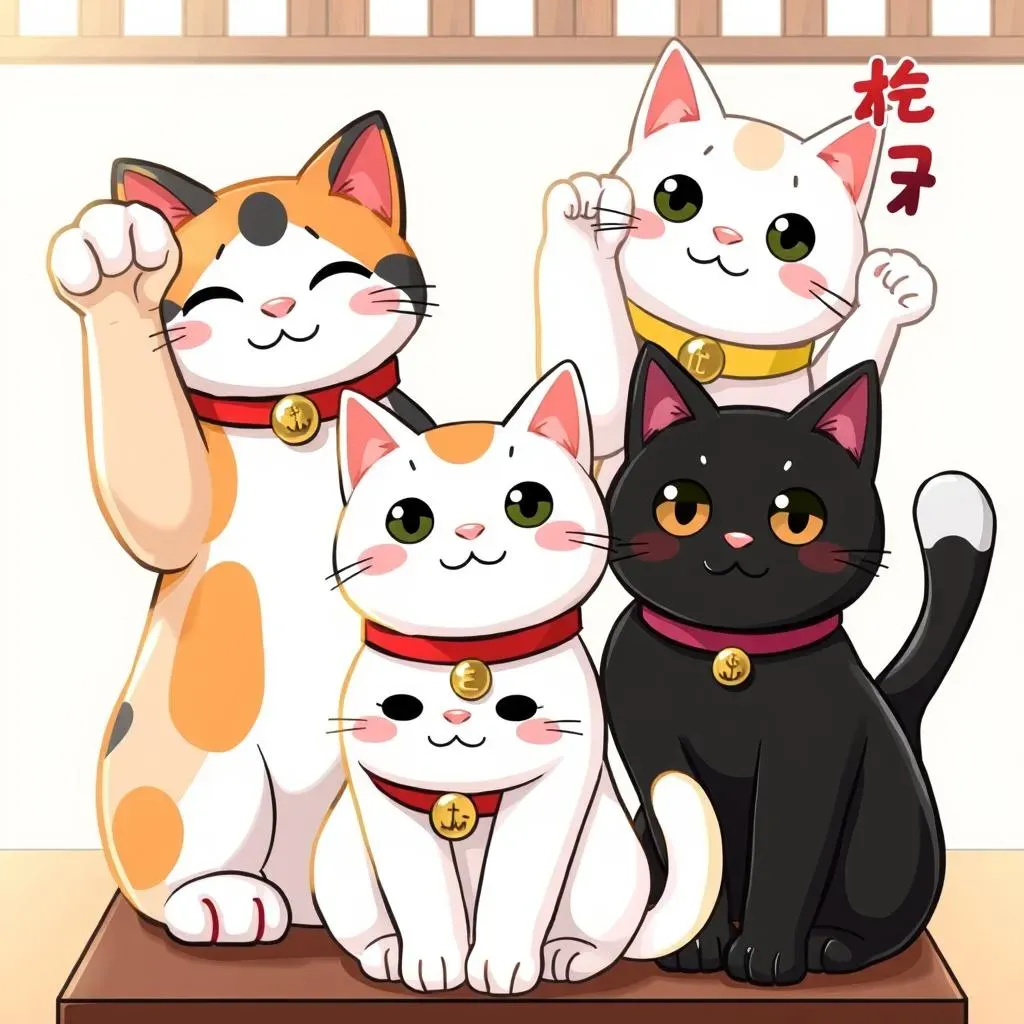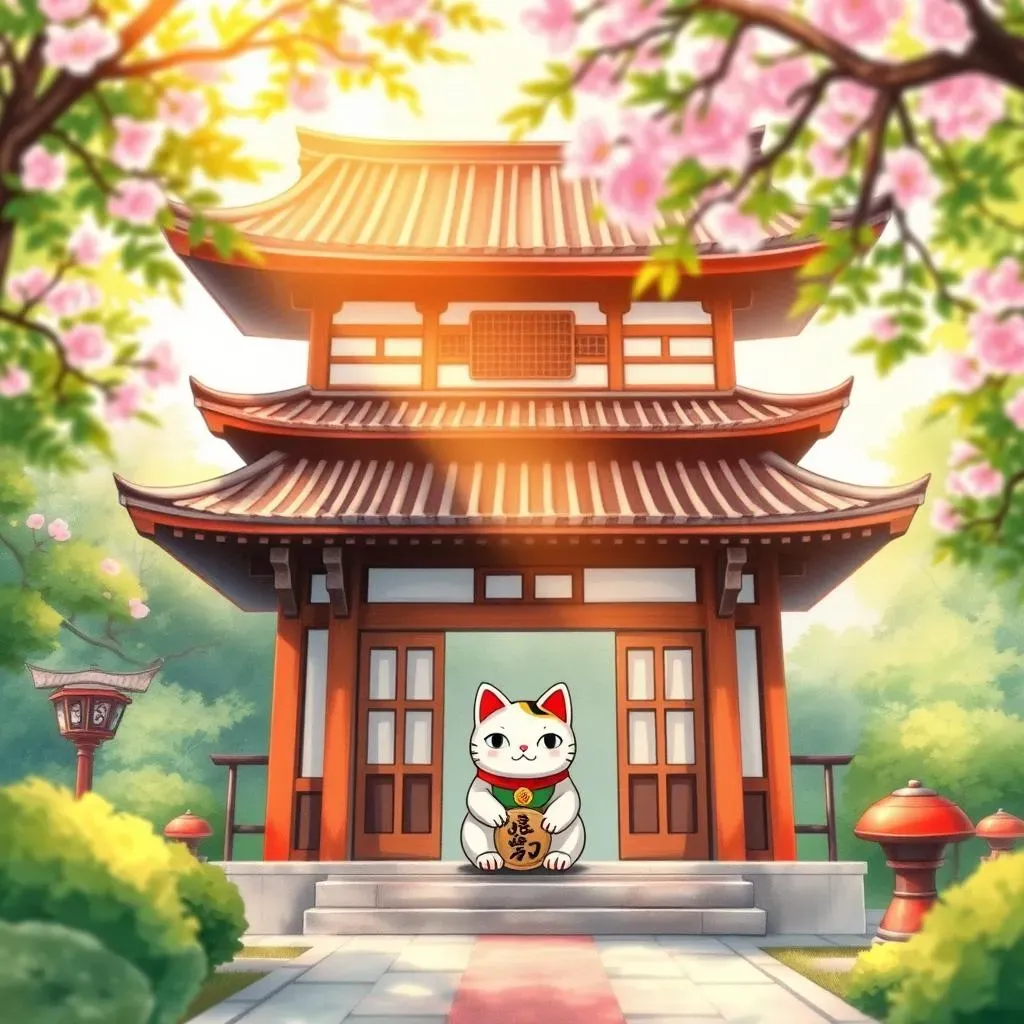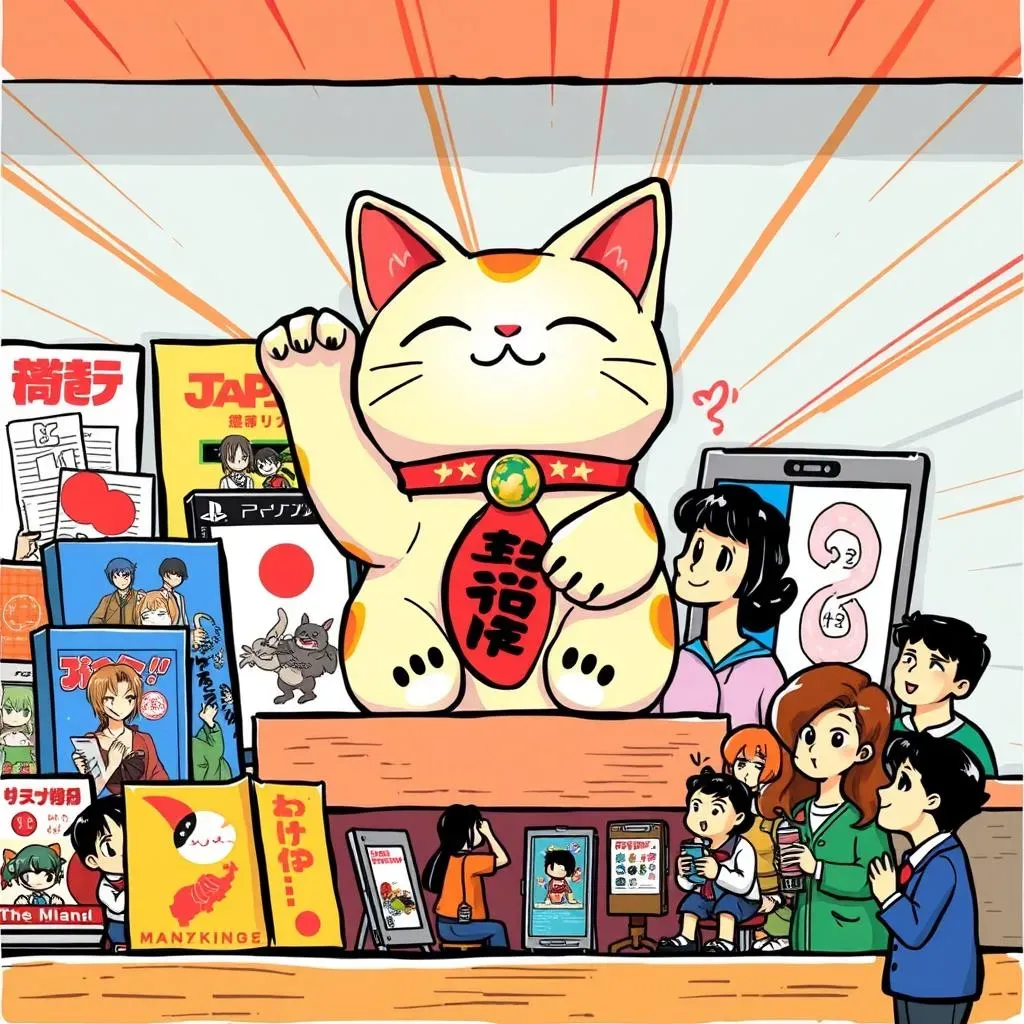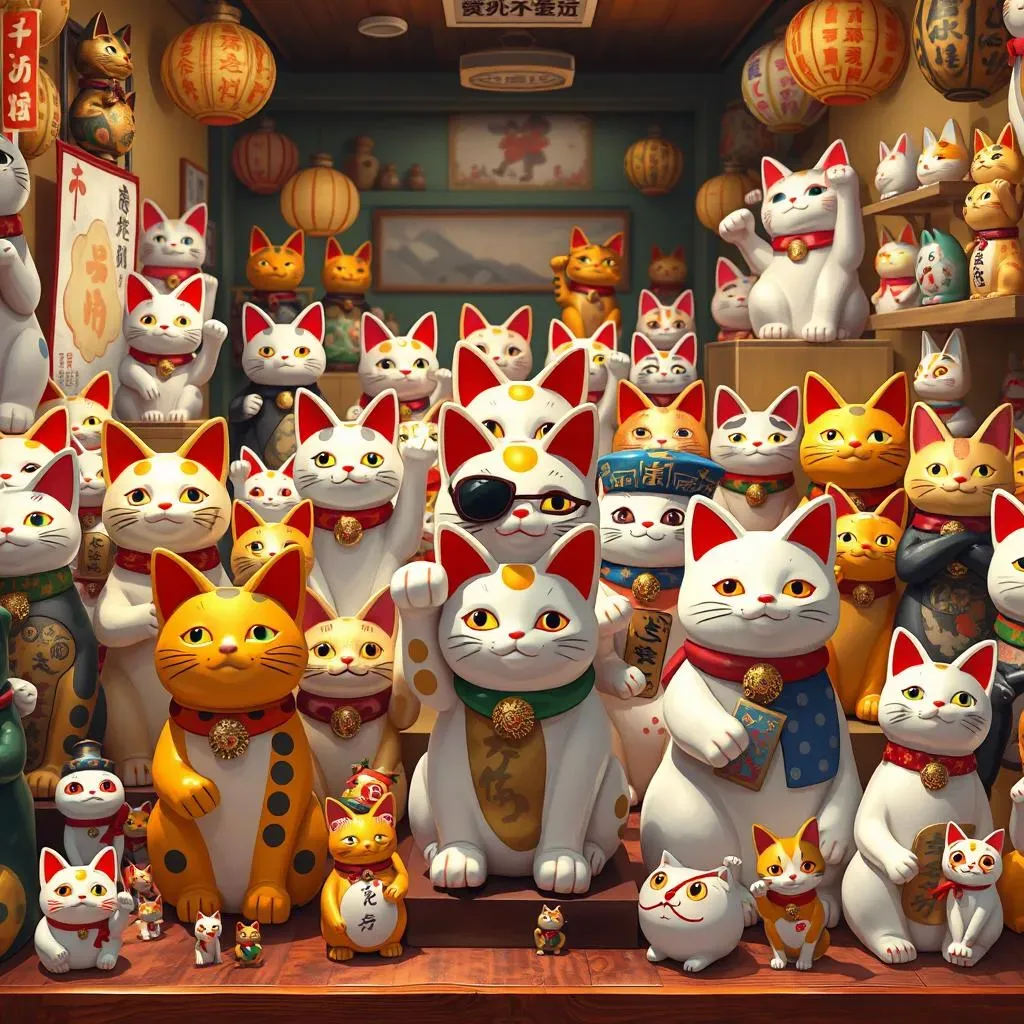Table of Contents
Ever seen a cute cat figurine with a raised paw, often in shops or restaurants? That's a Maneki-neko, also known as the "beckoning cat" or "lucky cat," and it's much more than just a decoration. This fascinating figure, often featuring a cat moving hand toy, is a cultural icon with a rich history and a whole lot of symbolism. It's not just a pretty face, it's believed to bring good fortune and attract customers, and for centuries, it has been a staple in Japanese culture. In this article, we'll explore the different aspects of the Maneki-neko, from its origins and unique characteristics to its place in popular culture. We will unravel the meaning behind its design, including why it's often a calico cat, and why the "cat moving hand toy" is so important. Get ready to discover the captivating story of this beloved feline figure and its journey from ancient folklore to modern-day icon.
Common Features of the Manekineko

Common Features of the Manekineko
The Iconic Raised Paw
Okay, so you've seen one, right? The most noticeable thing about a Maneki-neko is that raised paw. It's not just a cute wave. It's actually a beckoning gesture, like it's calling good luck and fortune your way. Think of it like a friendly "come here" signal, but for prosperity! The paw can be either the right or left, or even both, and each one has a different meaning. A raised right paw is said to invite money, while a raised left paw is believed to attract customers. Some figures have both paws raised, symbolizing a combination of both good fortune and prosperity.
The angle of the paw also matters. A slightly raised paw is a casual invitation, while a fully raised one is a very strong and earnest beckon. You'll see a lot of them with a paw that moves, like a little cat moving hand toy, which is designed to further emphasize the gesture. It's like the cat is actively trying to get your attention and draw in all the good stuff for you.
Paw | Meaning |
|---|---|
Right Paw Raised | Invites Money and Good Fortune |
Left Paw Raised | Attracts Customers |
Both Paws Raised | Combination of Good Fortune and Prosperity |
Color and Design
Beyond the paw, the colors of the Maneki-neko are quite significant. The classic calico cat, with its white, black, and orange patches, is the most common. This color is believed to be the luckiest. Other colors, like white, are said to bring purity and happiness; black is for warding off evil; red is for protection; and gold is for wealth. The cat is often depicted with a bib or scarf, sometimes with a small bell, which is thought to ward off evil and bad luck.
You'll also notice that the Maneki-neko has a very specific facial design: big, round eyes, a cute little nose, and a kind of smiling expression. This gentle appearance is part of its charm and appeal. It is also usually a Japanese Bobtail, a cat breed that has a short, stubby tail. All of these common features make the Maneki-neko instantly recognizable and beloved.
- Calico: Most common and luckiest.
- White: Purity and happiness.
- Black: Wards off evil.
- Red: Protection.
- Gold: Wealth.
History and Origins of the Beckoning Cat

History and Origins of the Beckoning Cat
So, where did this iconic cat come from? The exact origins of the Maneki-neko are a bit of a mystery, like trying to find a specific grain of rice in a field. There are a few popular stories, and they all seem to point back to the Edo period in Japan (1603-1868). One story tells of a wealthy lord who took shelter under a tree during a storm. He noticed a cat waving at him from the entrance of a nearby temple. Intrigued, the lord went to the temple, and right after, a bolt of lightning struck the tree where he had been standing. The cat had saved him! In gratitude, the lord became a patron of the temple, and the "beckoning cat" became a symbol of good luck.
Another tale involves a poor shop owner who was struggling to make ends meet. He took in a stray cat, and soon after, customers started flocking to his shop. This cat, it was said, would sit at the entrance and wave its paw, drawing people in. The shop owner started making the cat figurines in honor of this cat, and the rest is history. While these are just stories, they do highlight the cultural importance of the Maneki-neko and how it was always seen as a lucky charm. It's interesting how these stories, passed down over time, continue to add to the charm of the cat moving hand toy, and how it’s not just a decoration but a symbol of hope and prosperity.
Story Type | Description |
|---|---|
Temple Cat | A cat waves a lord to safety, who then supports the temple. |
Shop Cat | A cat draws customers to a struggling shop, bringing the owner good fortune. |
Beliefs and Symbolism Associated with the Cat Moving Hand Toy

Beliefs and Symbolism Associated with the Cat Moving Hand Toy
The Lucky Charm
Alright, so we know the Maneki-neko is cute, but what does it really mean? Well, it’s all about good fortune, like a furry little magnet for positive vibes. The belief is that having a Maneki-neko, especially one with a cat moving hand toy, will bring good luck, wealth, and prosperity. It's like having a tiny, charming mascot on your side. People often put them in businesses to draw in customers and boost sales, or in their homes for general good luck. It's not just a decoration; it’s a symbol of hope and good things to come.
The specific symbolism can vary a bit, depending on the color and the paw. But at its heart, the Maneki-neko is a beacon of positive energy. It's like saying, "Hey, come on in, good things are happening here!" And that's why it's so popular. It's a tangible representation of the belief that good things can be drawn to you. The cat moving hand toy just amplifies that message, constantly beckoning in good fortune.
Symbolism | Meaning |
|---|---|
Good Fortune | Attracts positive events and opportunities. |
Wealth | Brings financial prosperity and success. |
Prosperity | Enhances overall well-being and abundance. |
Customer Attraction | Draws in customers to businesses. |
Feng Shui and the Maneki-neko
Now, let's talk a bit about Feng Shui. This ancient Chinese practice focuses on creating balance and harmony in your environment. And guess what? The Maneki-neko fits right in! It's often used as a tool to enhance the flow of positive energy in a space. The placement of the figurine is key: facing the entrance, it invites good fortune into the premises. It's like having a tiny, furry doorman ushering in the good stuff.
The different colors of the Maneki-neko also play a role in Feng Shui. For instance, a gold cat moving hand toy is placed in the wealth corner of a room to attract money, while a black cat is placed to ward off negative energy. It's all about using the cat's symbolic power to create a more harmonious and prosperous environment. It's not just a cute decoration; it’s a carefully chosen element with a specific purpose. It’s a beautiful blend of tradition and practicality.
- Placement: Facing the entrance to invite good fortune.
- Gold Cat: Placed in the wealth corner to attract money.
- Black Cat: Placed to ward off negative energy.
Manekineko in Popular Culture

Manekineko in Popular Culture
Ubiquitous Symbol in Media
Okay, so you might be thinking, "I've seen these cats everywhere!" And you're probably right. The Maneki-neko has gone beyond just being a shop decoration. It's popped up all over the place, especially in media. You'll see it in anime, manga, video games, and even movies. It's often used as a symbol of good luck, wealth, or just as a cute, recognizable icon. Think of it as a visual shorthand for Japanese culture. I mean, who hasn't seen a little waving cat in a cartoon or game? It's become a sort of Easter egg, a nod to Japanese tradition that's instantly recognizable. The cat moving hand toy version, with its constant beckoning motion, is especially popular for animation, because it just adds a bit of extra charm and movement.
It's not just in Japanese media either, the Maneki-neko has made its way into Western pop culture too. You might spot it in a quirky store, on a t-shirt, or even as a character in a cartoon. It's like it's become a universal symbol of good vibes, something that people from different cultures can connect with. This little cat has really made a global journey, and it's pretty impressive how it's managed to stay relevant and beloved across different cultures and generations. It is a good example of how a cultural symbol can be adapted and embraced globally.
Media Type | Examples |
|---|---|
Anime and Manga | Various cameos and character designs. |
Video Games | Collectible items or lucky charms. |
Movies | Background props or symbolic elements. |
Beyond Entertainment
But the Maneki-neko's influence doesn't stop at entertainment. It's also used in advertising and even politics! Companies often use the image of the cat to promote their products, associating them with good luck and prosperity. It's a smart move, because who doesn't want a bit of good fortune with their purchase? Political campaigns, too, have used the cat as a symbol of hope and positive change. I think it's quite interesting how a simple figurine can be transformed into a powerful symbol for various causes and campaigns.
The Maneki-neko has also become a popular collectible. People love to gather different versions of the cat, with varying colors, sizes, and designs. It's like a little hobby, collecting these adorable figures and filling your home with good luck. Whether it's a traditional ceramic statue or a modern, funky design, the Maneki-neko continues to captivate people with its charm and symbolism. It's a testament to the enduring appeal of this cultural icon, and how it has managed to weave its way into so many different aspects of modern life.
- Advertising: Used to promote products and services.
- Politics: Symbol of hope and positive change.
- Collectibles: Varied designs and colors for enthusiasts.
Gallery of Manekineko

Gallery of Manekineko
A World of Waving Cats
Alright, let's get to the fun part – the visuals! When you start looking at the sheer variety of Maneki-neko out there, it's like stepping into a candy store, but instead of sweets, you get adorable, waving cats. From traditional ceramic figurines to modern, colorful designs, the range is pretty amazing. You'll find them in all shapes and sizes, some small enough to fit in your pocket and some big enough to be a centerpiece in a shop window. It's not just about the size though, each one has its own unique personality and charm.
The materials they are made from also vary widely: you have the classic ceramic, but also plastic, wood, even fabric ones. Each material gives it a different feel and adds to its unique appeal. The level of detail can be quite impressive too, some are simple and minimalist, while others are intricately painted and decorated. It is quite something to see how far the Maneki-neko has evolved, and how many different forms it now exists in. I bet you could spend days looking at them all!
Material | Description |
|---|---|
Ceramic | Traditional and classic look. |
Plastic | Durable and often more affordable. |
Wood | Natural and rustic feel. |
Fabric | Soft and cuddly versions. |
Traditional vs. Modern
Now, let's compare the old-school Maneki-neko with the new kids on the block. Traditional ones are often made of ceramic, with a classic calico pattern and a simple, elegant design. They're the kind you might see in an old Japanese shop, and they have a certain timeless quality to them. These are the ones that really capture the history and tradition of the Maneki-neko, they are like small pieces of history.
On the other hand, modern Maneki-neko are a total explosion of creativity! You'll find them in bright, bold colors, with funky patterns, and even with added accessories like sunglasses or hats. They often incorporate new materials and techniques. These modern versions are a fun and playful take on the classic design. I find it interesting how the same basic concept can be interpreted in so many different ways, it really shows how versatile the Maneki-neko can be.
Beyond the Figurine
But the Maneki-neko isn't just about figurines anymore. You can find it on everything from t-shirts and phone cases to keychains and even tattoos. It's like the cat has jumped off the shelf and into our everyday lives. It's a great example of how a cultural icon can evolve and adapt to new forms of expression. This also shows how much people really love this design, they want to take it with them everywhere.
And it's not just about consumer goods either. Artists have been inspired by the Maneki-neko, creating incredible paintings, sculptures, and even digital art. It's like the cat has become a muse for creative minds. It’s fascinating to see how different artists interpret this iconic figure in their own unique ways. The Maneki-neko has become a symbol that everyone can connect with, whether you like the traditional or the modern approach, there is a version for everyone.
- T-shirts and Apparel: Trendy designs featuring the cat.
- Phone Cases and Accessories: Portable good luck charms.
- Art and Sculptures: Creative interpretations of the figure.
See Also

See Also
So, you've learned all about the Maneki-neko, the beckoning cat that brings good luck. But, like any good story, there are always related topics that might pique your interest. If you're fascinated by Japanese culture, you should check out other lucky charms and symbols. There's the Daruma doll, a round, red figure that represents perseverance, or the Omamori, small amulets sold at temples for good fortune and protection. These items, like the cat moving hand toy, all have deep roots in tradition and offer a glimpse into the beliefs and values of Japanese society.
And if you're into cats in general, why not look into other famous cats from around the world? There's the Cheshire Cat from Alice in Wonderland, with his enigmatic grin, or the many cats that appear in Egyptian art and mythology, revered for their grace and mystery. These feline figures, like the Maneki-neko, show how cats have captured our imaginations across different cultures and time periods. It's really fascinating how these animals have woven their way into our stories and beliefs, and how they can represent so many different things.
Related Topic | Description |
|---|---|
Daruma Doll | A round, red figure representing perseverance. |
Omamori | Amulets sold at temples for good fortune. |
Cheshire Cat | Enigmatic cat from Alice in Wonderland. |
Egyptian Cats | Cats revered in Egyptian art and mythology. |
References

References
Where Did All This Info Come From?
Alright, so you've journeyed with me through the world of the Maneki-neko, the charming cat moving hand toy. But you might be wondering, "Where did all this information come from?" Well, like any good article, it's important to give credit where credit is due. I've pulled together information from various sources – books, websites, and even some academic papers. It's like being a detective, piecing together the puzzle of this fascinating figurine. I did my best to find reliable sources to make sure the information is accurate and engaging.
The beauty of researching a topic like this is that there are so many different perspectives and stories to uncover. It's not just about reciting facts; it's about understanding the cultural significance and the folklore that surrounds the Maneki-neko. I tried to combine the historical background with personal anecdotes and interesting trivia to make the article as informative and engaging as possible. I hope I've managed to capture the magic and the mystique of this beloved cultural icon.
Source Type | Description |
|---|---|
Books | Detailed historical and cultural analyses. |
Websites | Online resources offering diverse perspectives. |
Academic Papers | Scholarly research on the Maneki-neko. |
Further Reading and Exploration
Now, if you're itching to know even more about the Maneki-neko, I've got some recommendations for you. There are tons of great resources out there if you want to go deeper. You can find books that explore Japanese folklore and symbolism, which will give you a greater understanding of the Maneki-neko’s cultural context. There are also some fantastic websites dedicated to Japanese art and culture that offer a wealth of information on the topic.
Exploring the world of the Maneki-neko is like going on a treasure hunt; you never know what interesting tidbits you'll uncover. I'd recommend checking out museums and cultural institutions that have collections of Japanese art and artifacts. You'll be amazed at how much there is to discover about this fascinating cultural icon. And who knows, maybe you'll even find your own Maneki-neko to bring good luck into your life.
- Books on Japanese folklore and symbolism.
- Websites dedicated to Japanese art and culture.
- Museums with collections of Japanese art and artifacts.